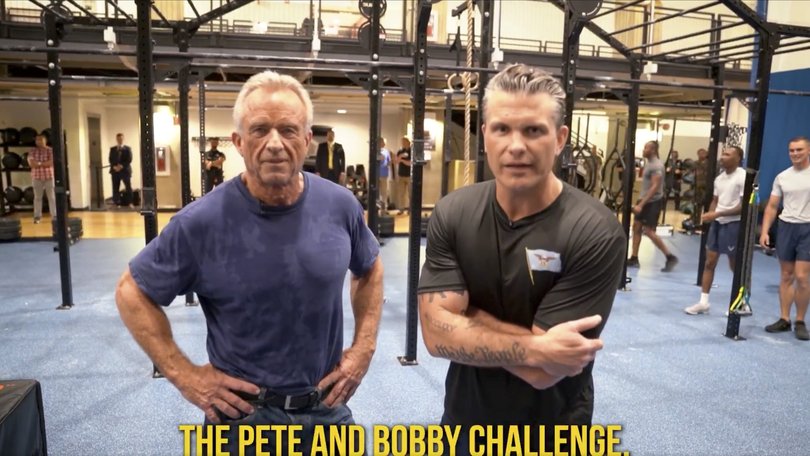NEW YORK TIMES: 100 pushups & 50 pullups in 10 minutes. What’s wrong with Kennedy, Hegseth fitness challenge

Recently, Robert F Kennedy Jr. challenged Pete Hegseth to a test of fitness in which each of them would do 50 pullups and 100 pushups in 10 minutes or less.
“Try to get under five minutes,” Mr Kennedy, the US health secretary, said of each section of the challenge, while wearing his standard gym attire of a tucked-in T-shirt and jeans.
The “Pete and Bobby Challenge,” as Mr Hegseth, the secretary of defence, called it, circulated widely in videos posted to social media by both men, as well as to the YouTube account of the Department of Health and Human Services. The challenge might have seemed novel to some, but high-volume calisthenic couplets like this are nothing new — and fitness experts caution they may not be for everyone.
Sign up to The Nightly's newsletters.
Get the first look at the digital newspaper, curated daily stories and breaking headlines delivered to your inbox.
By continuing you agree to our Terms and Privacy Policy.The timed grouping suggested by Kennedy was similar to the Physical Screening Test for Navy Special Operations, commonly known as the PST, which is the first step to becoming a Navy SEAL. The PST features situps, running, swimming, pullups and pushups. The minimum requirements are 50 pushups in less than two minutes and 10 pullups, unbroken, without dropping from the bar.
Training methods and field exercises developed for the SEALs have routinely been taken up by fitness enthusiasts. One notable adaptation is the Murph Challenge, a gruelling CrossFit annual fundraiser created in honour of Lt. Michael Murphy, a Navy SEAL who was killed in Afghanistan in 2005 and was awarded the Medal of Honour in 2007. (His story is told in the film “Lone Survivor.”) That workout starts with a 1-mile run and then requires 100 pullups, 200 pushups and 300 squats before a second 1-mile run — all while wearing a weighted vest made to look like body armour.

Combining large amounts of pullups, pushups and squats has been a staple of the CrossFit workout since late 2003, when that grouping was introduced as the “Chelsea.” But even for advanced athletes, these types of high-intensity combos — a test of cardiovascular capacity, strength and endurance — can be a grind.
One of the key features of the “Murph,” which takes elite athletes around 40 minutes to complete, is that the pullups are rarely done “strict” — a term indicating full control and slow, steady form. Instead, athletes are encouraged to either “kip” or use “butterfly” pullups, variations that are considerably easier on the shoulders and arms, but are still difficult to master.
“As the sport of CrossFit evolved, so too did the movement requirements needed,” said John Christian Singleton, a coach and the owner of The Progrm, a training app for athletes. The variations on pullups, according to Singleton, came because “ultimately, athletes needed to do more reps in less time.”
Dallin Pepper, a Utah-based athlete who is part of the World Fitness Project, a functional fitness competition tour, and who has competed at the CrossFit Games, said that anyone wanting to approach such a challenge should work up to it gradually.
“For the average person, I would definitely recommend building volume in these movements over three to four weeks before giving it a go,” he said.
Fitness experts said Kennedy and Hegseth were trying to do standard pullups, rather than employing “kips” or the “butterfly” movement. But their shortened range of motion — neither reaching above the bar with the chin, nor fully extending the arms on the descent — falls short of both CrossFit and military standards.
“That is not how you do a qualified, correct pullup in the military,” said Jess Hviid Skov, owner of the Frontline Box gym and a former sergeant in the Danish military.
Despite that, Kennedy, who has routinely talked about the benefits of fitness, seemed to invite average Americans to challenge themselves physically in the same way he and Hegseth had, with a post on X that read: “100 push-ups, 50 pull-ups — Who’s up for the challenge?”
Multiple fitness experts believe such a regimen is not feasible for a majority of the population.
“Most people can’t even perform five strict pushups with proper form, or a single pullup, without compensating,” said Chris Smits, a personal trainer based in Toronto. “Pushing for such high numbers without the necessary strength foundation can quickly lead to poor form, overcompensation and a high risk of injury, including serious muscle strains or tears.”
Mr Smits added that it “isn’t about hitting an arbitrary number on Day 1” and that strength should be built gradually.
Cesar Toledo, a trainer and physiotherapist at Brockton Physiotherapy in Toronto, said that he recommended “focusing on the quality of the movements” rather than the target number or timing. “The goal of getting people moving is great,” he added, but a challenge like this would increase injury risk because of the stress it places on a participant’s shoulders.
And Ben Bergeron, the founder of the global training company CompTrain, warned that the simplicity of pushups and pullups should not be underestimated.
“High-volume body weight workouts are deceptively tough,” he said. “The movements themselves are simple, but when performed in the 50 to 100 rep range or more — most people aren’t prepared for it.”
© 2025 The New York Times Company
Originally published on The New York Times
